Key takeaways:
- Exploratory testing emphasizes intuition and flexibility, allowing testers to uncover critical issues by embracing curiosity rather than following rigid scripts.
- It fosters collaboration within teams, enhancing problem-solving through shared insights and discussions about findings.
- Key challenges include the absence of clear documentation, balancing breadth and depth in testing, and managing time constraints effectively.
- Documentation and reflection after sessions are vital for tracking insights and improving future testing efforts.
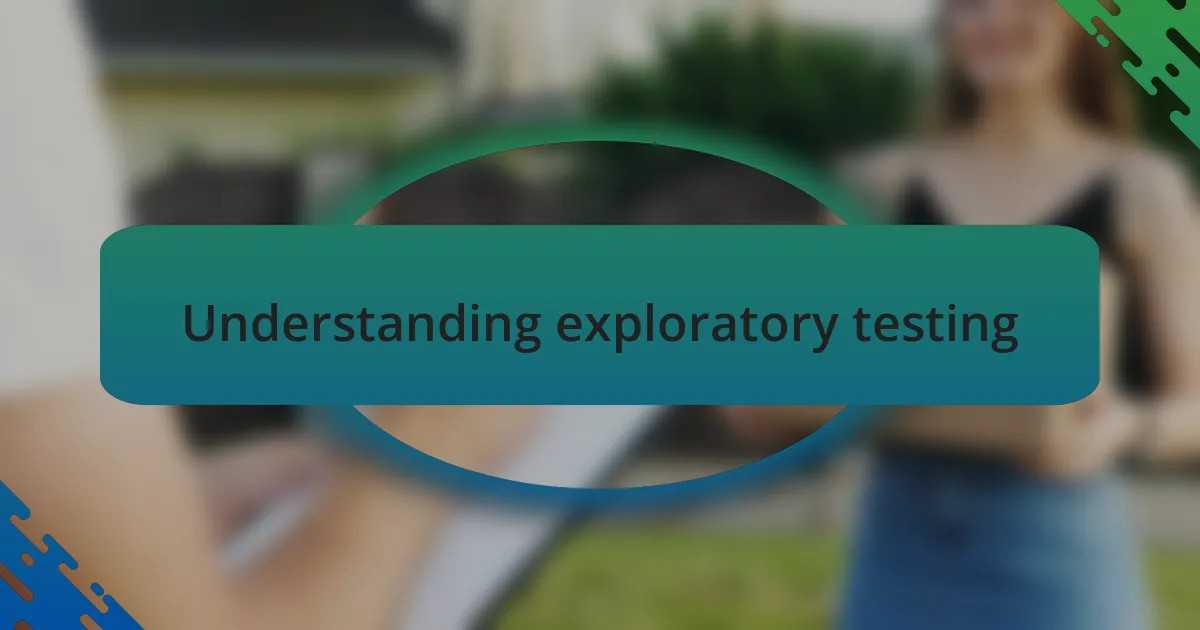
Understanding exploratory testing
Exploratory testing, at its core, is about discovering the unknowns of a software application. I remember the rush I felt during a testing session where I uncovered a critical bug that hadn’t been documented – it was like finding a hidden treasure! This testing method encourages testers to rely on their intuition and experience rather than scripted scenarios, leading to more organic and insightful findings.
What I appreciate most about exploratory testing is its flexibility. There’s something liberating about being able to wander through a website, playing with features without a rigid structure. Have you ever entered a site and instinctively clicked on something unexpected? That’s the essence of exploratory testing—embracing curiosity and allowing it to guide you toward issues that standard tests might overlook.
While structured testing has its place, I often find that exploratory testing offers a unique platform for innovation. I’ve seen countless times how this approach leads to richer feedback and a deeper understanding of user experience. Isn’t it fascinating how a simple change in perspective can transform the outcome of a testing process? By putting myself in the user’s shoes, I could identify vulnerabilities that mattered most to the audience.
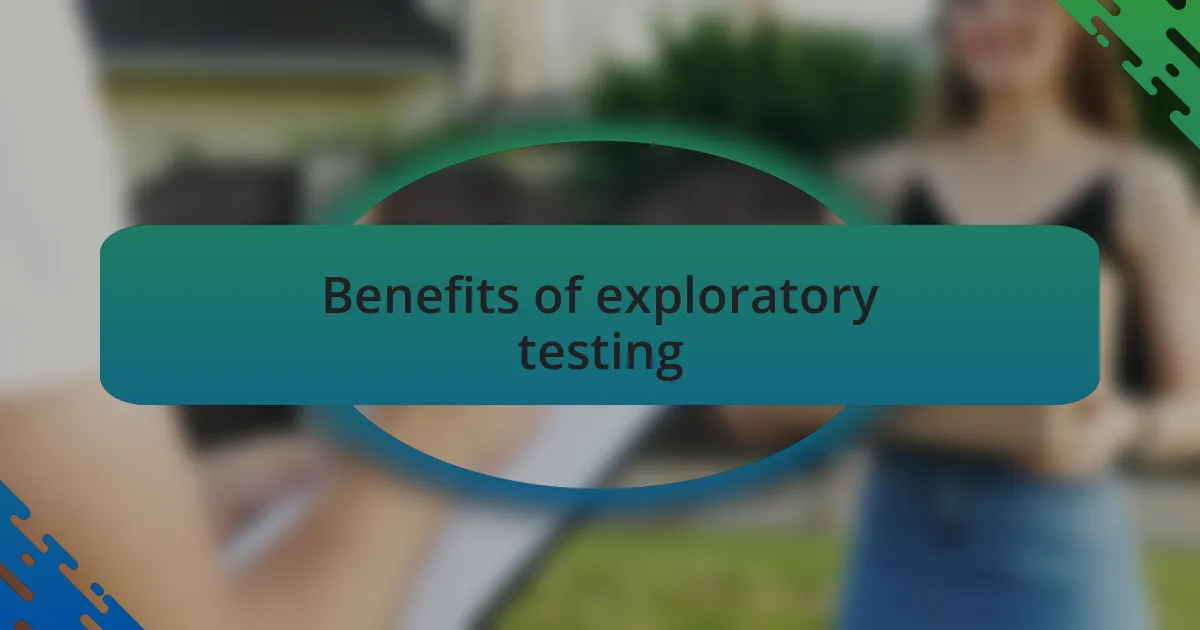
Benefits of exploratory testing
One significant benefit of exploratory testing is the ability to uncover issues early in the development cycle. I recall a particular instance where I was tasked with testing a new feature. Instead of adhering strictly to a predefined script, I decided to explore the functionality freely. It was during this exploration that I discovered multiple UI inconsistencies that could have affected user satisfaction. Isn’t it impressive how a little freedom in testing can lead to early problem detection?
Another advantage is the promotion of collaboration within the team. When I engage in exploratory testing sessions, I often bring my findings to team discussions. This not only sparks insightful conversations but also invites others to brainstorm solutions. Have you ever shared a unique perspective in a group setting? It can transform the dialogue and foster a sense of collective ownership over the product quality.
Lastly, exploratory testing nurtures a mindset of continuous learning. Every session feels like an opportunity to enhance my skills and deepen my understanding of the software. With each exploration, I find myself questioning assumptions and seeking innovative ways to tackle challenges. Isn’t it rewarding to grow both personally and professionally through the testing process? Through this ever-evolving journey, I’ve gained a greater appreciation for the art of software development.
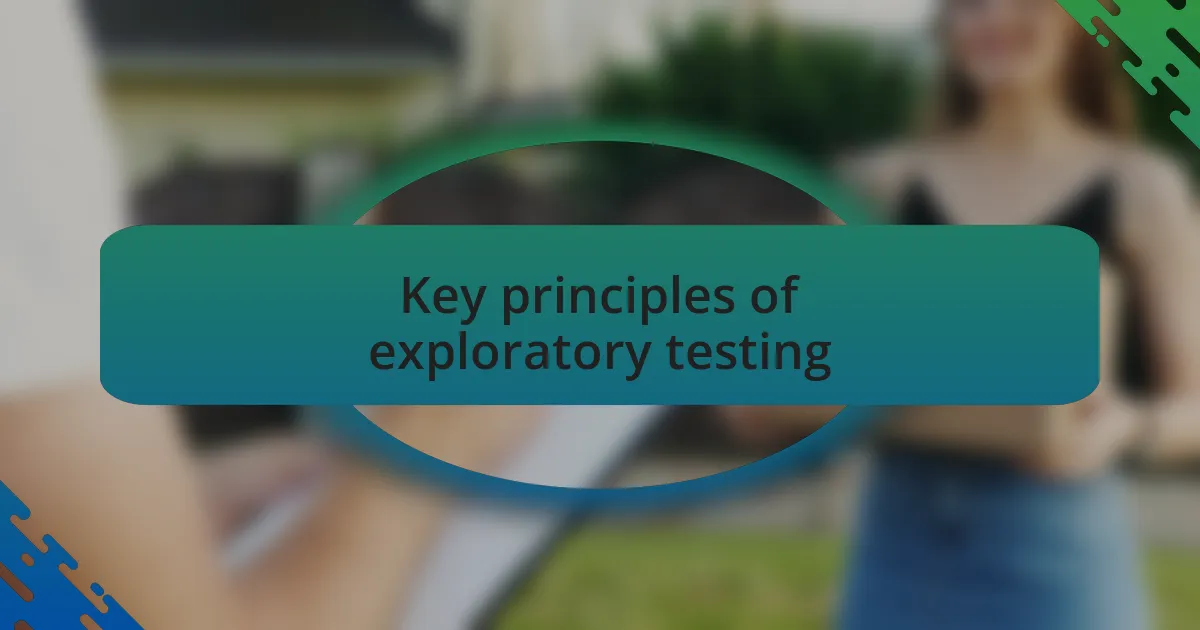
Key principles of exploratory testing
One key principle of exploratory testing is the focus on the tester’s experience and intuition. I remember a project where I relied heavily on my prior knowledge of user behaviors. This intuition led me to simulate real-world scenarios that weren’t part of the original test plan. How often do we assume we know what users will do, only to be surprised by their actual behaviors? This practice emphasizes the importance of a tester’s analytical mindset, as it can reveal unexpected insights that standard testing may overlook.
Another essential principle is the adaptability of exploratory testing. There are times when I’ve encountered unexpected software responses that completely altered my testing approach. In one case, a bug triggered a chain reaction of failures in other functionalities. This adaptability means I can shift my focus quickly, which is crucial during tight deadlines. Isn’t it fascinating how being flexible can turn a potential setback into a unique discovery opportunity?
Lastly, exploratory testing thrives on documentation and reflection. After each session, I find it incredibly beneficial to jot down my observations and thoughts. This allows me to track patterns and nuances that may not be evident at first glance. I often ask myself, “What did I learn today that could improve my future testing?” This reflection not only enhances my skills but also builds a knowledge base that my team can benefit from. By documenting my journey, I create a roadmap for continuous improvement, both in my personal development and for the project’s success.
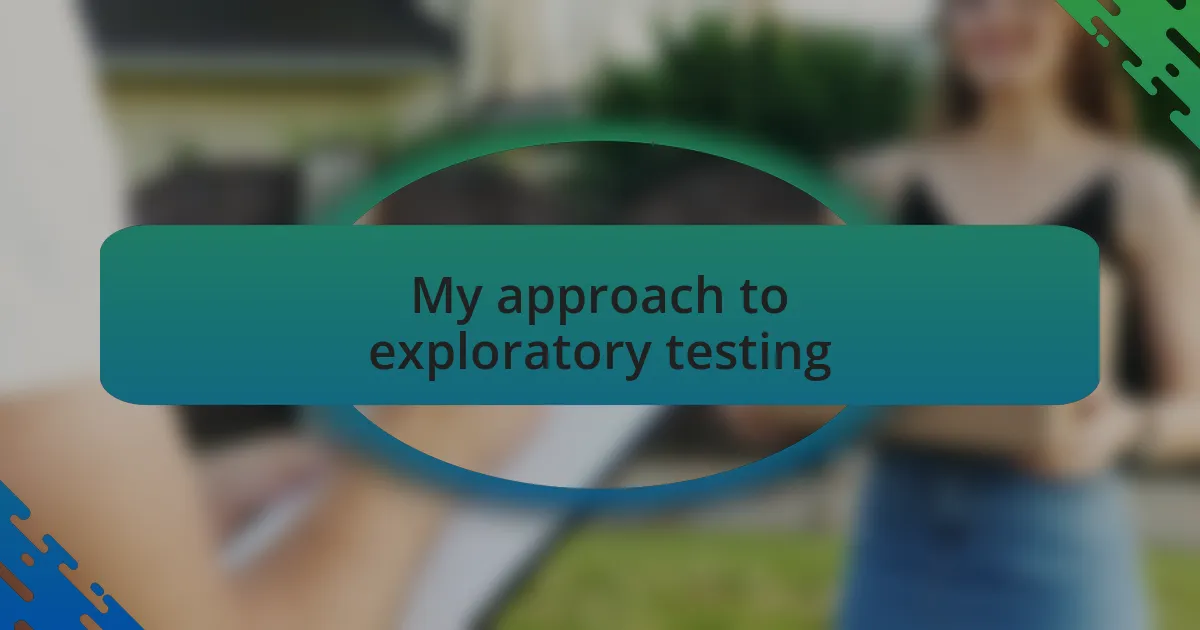
My approach to exploratory testing
When I dive into exploratory testing, my approach is often driven by curiosity. I recall a time when, while exploring a new website feature, I stumbled upon a user interface element that behaved unexpectedly. This moment made me question how well the design aligned with user expectations. It’s this kind of inquisitive mindset that not only enhances my testing but also leads to discoveries that can significantly improve user experience.
I also prioritize time management during exploratory sessions. For instance, I set aside specific time blocks where I’m completely immersed in testing, free from distractions. This focused period allows me to harness my observations effectively, making each moment count. Have you noticed how a dedicated time slot can amplify your productivity? I’ve found that it does, and being intentional about my time allows for deeper exploration and analysis.
Collaboration plays a crucial role in my exploratory testing. After each session, I often sit down with my team to share findings and brainstorm potential solutions. One memorable discussion led to a significant redesign that addressed several usability issues I uncovered. It’s remarkable how a simple conversation can spark new ideas and drive improvements. Don’t you agree that involving others enriches the testing process and fosters a culture of innovation?
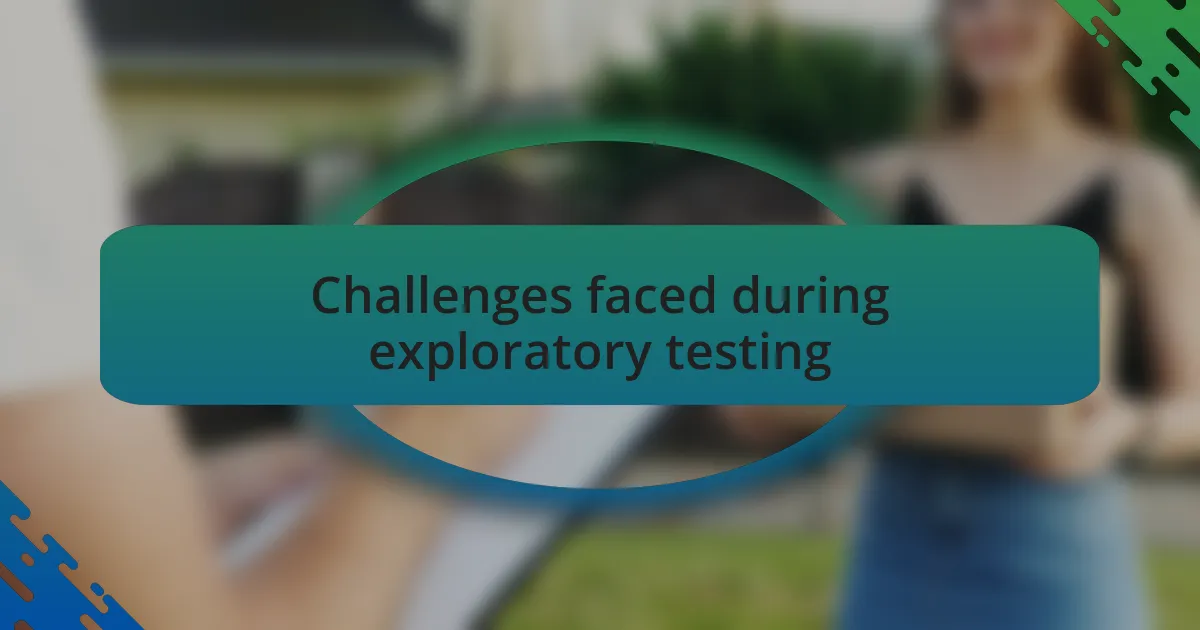
Challenges faced during exploratory testing
One significant challenge I often encounter during exploratory testing is the absence of clear documentation. I remember a project where a lack of specifications left me guessing about intended functionalities. This uncertainty not only slowed my progress but also raised doubts about whether I was testing the right things. Have you ever felt lost without a map? It can be frustrating, especially when you want to ensure that every edge case is covered.
Another hurdle is the balance between breadth and depth in testing. During one session, I was so eager to explore various features that I overlooked deeper issues in the core functionality. This taught me that while it’s important to cover a lot of ground, prioritizing key areas for thorough investigation is vital. How do you determine where to focus your energy? I’ve learned to trust my instincts and concentrate on high-risk elements first.
Time constraints can also create stress during exploratory testing. I’ve had instances where the clock seemed to race, leaving me feeling rushed to document findings rather than enjoying the discovery process. In those moments, I realize how crucial it is to maintain a steady pace; after all, quality insights often emerge when I allow myself the space to think critically. Have you experienced that pressure? It’s a balancing act, but finding that rhythm between speed and thoroughness helps me produce more valuable outcomes.
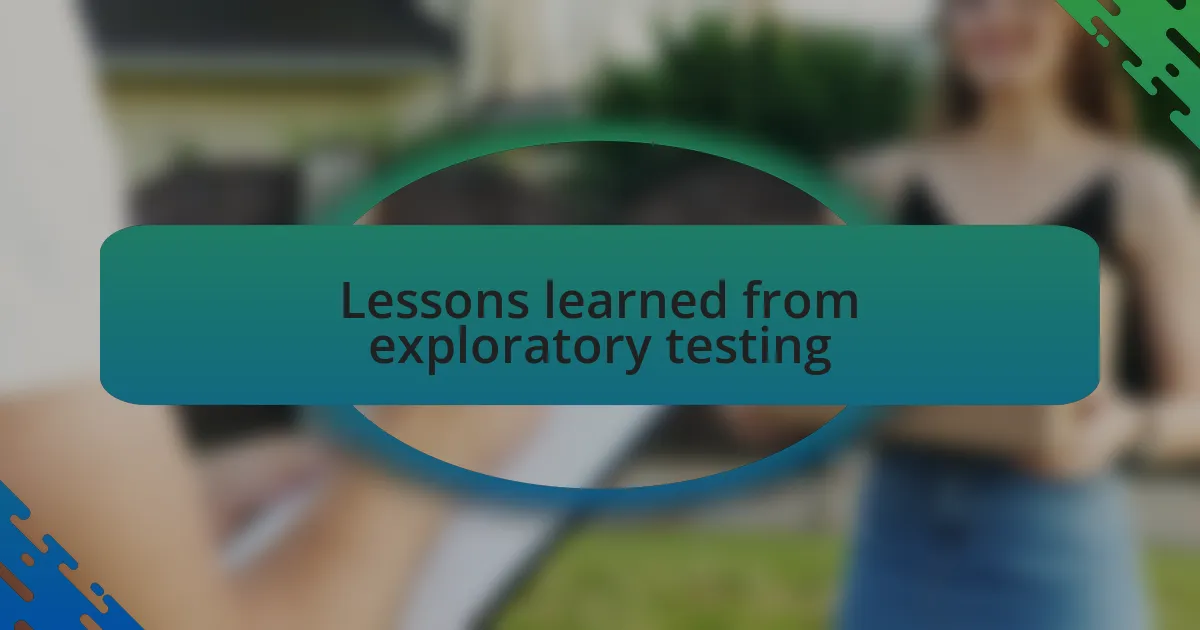
Lessons learned from exploratory testing
One key lesson I took from exploratory testing is the value of adaptability. I recall an instance where a sudden change in project requirements required me to pivot my testing approach on the fly. I learned that being flexible and open to shifting priorities can uncover significant issues that rigid testing methods often miss. Have you ever had to change direction mid-course? Embracing those changes can lead to richer insights!
Another enlightening moment came when I discovered the power of collaboration. During a testing session, I engaged in a brainstorming discussion with developers and product managers. This exchange opened my eyes to new perspectives I hadn’t considered and helped identify critical problem areas. It made me realize that sharing experiences and insights makes the process more comprehensive. Why work in isolation when the team can enhance the exploratory journey together?
The importance of documenting findings in real-time became strikingly clear through my experiences. I remember neglecting to jot down certain discoveries while testing, only to forget them moments later. This oversight ultimately led to missed opportunities for improvement. Have you ever wished you had captured a fleeting thought? Now, I make it a point to pause regularly to record insights, making the entire testing process more impactful.